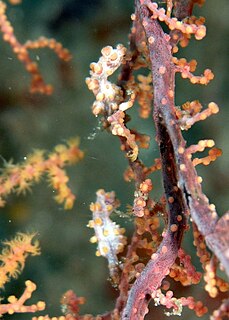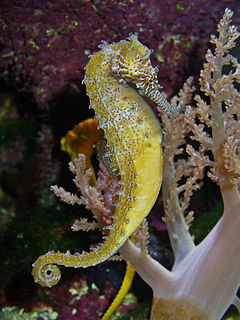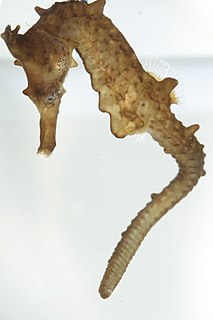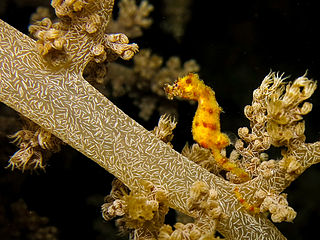
A seahorse is any of 46 species of small marine fish in the genus Hippocampus. "Hippocampus" comes from the Ancient Greek hippokampos, itself from hippos meaning "horse" and kampos meaning "sea monster". Having a head and neck suggestive of a horse, seahorses also feature segmented bony armour, an upright posture and a curled prehensile tail. Along with the pipefishes and seadragons they form the family Syngnathidae.

The Syngnathiformes are an order of ray-finned fishes that includes the pipefishes and seahorses.

The big-belly seahorse or pot-bellied seahorse is one of the largest seahorse species in the world, with a length of up to 35 cm (14 in), and is the largest in Australia. Seahorses are members of the family Syngnathidae, and are teleost fishes. They are found in southeast Australia and New Zealand, and are listed on Appendix II of CITES.

The pygmy seahorses comprise several species of tiny seahorse in the syngnathid family or Syngnathidae. Family Syngnathidae is part of order Syngnathiformes, which contains fishes with fused jaws that suck food into tubular mouths. They are found in Southeast Asia in the Coral Triangle area. They are some of the smallest seahorse species in the world, typically measuring less than 2 centimetres (0.79 in) in height.

Hippocampus bargibanti, also known as Bargibant's seahorse or the pygmy seahorse, is a seahorse of the family Syngnathidae found in the central Indo-Pacific area.
Hippocampus angustus, commonly known as the narrow-bellied seahorse, western Australian seahorse, or western spiny seahorse, is a species of marine fish of the family Syngnathidae. It is found in waters off of Australia, from Perth to Hervey Bay, and the southern portion of Papua New Guinea in the Torres Strait. It lives over soft-bottom substrates, adjacent to coral reefs, and on soft corals at depths of 3–63 metres (9.8–206.7 ft). It is expected to feed on small crustaceans, similar to other seahorses. This species is ovoviviparous, with males carrying eggs in a brood pouch before giving birth to live young. This type of seahorse is monogamous in its mating patterns. The males only fertilize one female's eggs for the mating season because of the population distribution. While some seahorses can be polygamous because they are denser in population, this type of seahorse is more sparsely distributed and the cost of reproduction is high. Therefore, the risk to reproduce due to predatory and distributary factors limits this breed to one mate, often finding the same mate season after season.

Barbour's seahorse is a species of fish of the family Syngnathidae.

The Réunion seahorse is a synonym of Hippocampus kuda, Weber, 1913. It is found in Madagascar, Mauritius, Mozambique, Réunion, South Africa, and Tanzania. Its natural habitat is subtidal aquatic beds. It is threatened by habitat loss.

Hippocampus coronatus, commonly known as the high-crowned seahorse or crowned seahorse, is a species of fish of the family Syngnathidae. It is endemic to the Pacific coastal waters of Japan, where it lives among Zostera seagrasses. It can grow to lengths of 10.8 centimetres (4.3 in), but is more commonly 6 centimetres (2.4 in). Individuals feed mainly on small crustaceans such as gammarid amphipods and copepods, although this can vary by size, with smaller individuals consuming copepods while larger individuals feed on amphipods and mysids. This species is ovoviviparous, with males brooding eggs in a brood pouch before giving birth to live young. Breeding season occurs from June to November, with females and males reaching sexual maturity at 6.9 centimetres (2.7 in) and 7.3 centimetres (2.9 in) respectively. Male brood size ranges from 12–46. The International trade in this species has been monitored through Appendix II of the CITES licensing system since 2004 and a minimum size of 10 centimetres (3.9 in) applies to traded specimens.

Hippocampus kuda, also known as the common seahorse, estuary seahorse, yellow seahorse or spotted seahorse is a seahorse of the family Syngnathidae native to the Indo-Pacific. The common name sea pony has been used for this species under its synonym Hippocampus fuscus.

Shiho's seahorse or Sindo's Seahorse, painted seahorse is a species of fish in the family Syngnathidae. It is endemic to the Pacific coastal waters of Japan. This species reaches a length of ca. 8 cm. It was listed by the IUCN Red List as Vulnerable in 1996 and Data Deficient in 2003, but was later reclassified as Least Concern. The specific name honours Michitaro Sindo, who was originally from Yamaguchi and who was assistant curator of fishes at Stanford University.

The flat-faced seahorse, longnose seahorse, low-crowned seahorse or three-spot seahorse is a species of fish in the family Syngnathidae. It is found in Australia, Cocos (Keeling) Islands, French Polynesia, Hong Kong, India, Indonesia, Japan, the Philippines, Singapore, Taiwan, Thailand, and Vietnam. Its natural habitat is shallow seas. It is threatened by habitat loss.

The spiny seahorse, also referred to as the thorny seahorse, is a small marine fish in the family Syngnathidae, native to the Indo-Pacific area. It is classified as a Vulnerable species by the IUCN.

The Hippocampinae are a subfamily of small marine fishes in the family Syngnathidae. Depending on the classification system used, it comprises either seahorses and pygmy pipehorses, or only seahorses.

Hippocampus waleananus, the Walea soft coral pygmy seahorse, was regarded as a synonym of Hippocampus satomiae, Lourie & Kuiter, 2008, however, some taxonomists suggested this name should be valid. The species was described in 2009 from a single specimen which was found close to the island Walea. This species is endemic to the Togian Islands in Indonesia, and is associated with specific soft corals.
Hippocampus biocellatus, or the false-eyed seahorse, is a synonym of Hippocampus planifrons, Peters, 1877.

Hippocampus severnsi is a synonym of Hippocampus pontohi, Lourie & Kuiter, 2008.
Hippocampus jugumus, the collared seahorse, was described in 2001 from a single specimen found in the waters surrounding Lord Howe Island.

Hippocampus pontohi, also known as Pontoh's pygmy seahorse or the weedy pygmy seahorse, is a seahorse of the family Syngnathidae native to the central Indo-pacific. Named after Hence Pontoh, the Indonesian dive guide from Bunaken (Manado) who first brought these pygmy seahorses to attention.
Hippocampus procerus, the high-crown seahorse, is a synonym of Hippocampus whitei, Bleeker, 1855.














